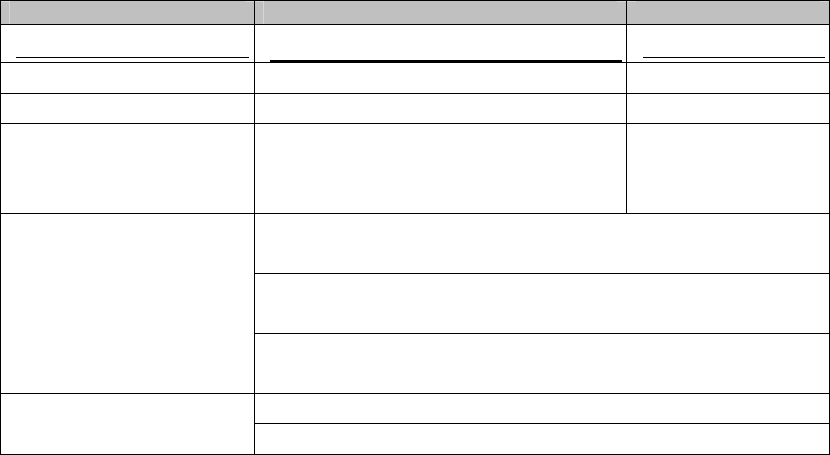Hisense Communication HISENSEEG59 CDMA and GSM dual mode phone User Manual Technical Manual
Hisense Communication Co., Ltd. CDMA and GSM dual mode phone Technical Manual
Contents
- 1. Technical Manual
- 2. User Manual
- 3. Technical manual
Technical Manual
Page 1 of 13
CDMA/GSM
Mobile
Phone
EG59
Technical Manual
Apr, 2010
Page 2 of 13
1. Introduction
EG59 mobile phone is designed and developed for CDMA/GSM network.
Its main features are:
The QUALCOMM single chip QSC6085 and MediaTek MT6223D
chipset are used, which feature Zero-IF and CMOS technology,
resulting high integration and great RF performance
Memory chips are 256MByte NAND/128MByte DDR and 64M bit
NOR/32M bit PSram MCP
65k colors, 320*240 TFT color LCD display
MIDI,MMF,AAC,MP3 ringtone
Camera
T-Flash memory card
Bluetooth
Touch panel
USB storage
2. Key Design Technology
2.1. Hardware:
CDMA/GSM/Bluetooth antenna design
technology Transmit link design technology
Receive link design technology
Frequency synthesize technology
RF control software compensation technology
Integrated system control technology
LCD implementation technology Interface
circuit design technology
Low power consumption design technology
High intensity PCB design technology
Ringtone quality improve technology
Components cost control
EMC/EMI design technology

Page 3 of 13
Reliability design technology
2.2. Software:
Reliable control of Flash & RAM
User-friendly UI design
Localized system capture optimization technology
Power consumption reducing software optimization technology
Systematic reliability design
3. Technical Specifications and Performance Parameters
3.1. General specifications
Item Content
Mode CDMA/GSM
Frequency Band CDMA 800MHz
Tx: 824 ~ 849MHz
Rx: 869 ~ 894MHz
GSM 900 MHz: (Used in European only)
Tx: 880 ~ 915MHz
Rx: 925 ~ 960MHz
DCS 1800 MHz: (Used in European only)
Tx: 1710-1785MHz
Rx: 1805-1880MHz
BLUETOOTH:
2402MHz to 2480MHz
Dimensions (L*W*D) 116mm×51mm×13.5mm
Working temperature -20 ~ +55°C
Storage temperature -30 ~ +60°C
Relative humidity 5% ~ 95%
Tx Output Power 23±2dBm Max (CDMA)
33±2dBm Max(GSM)
29±2dBm Max(DCS)
-6~+4dBm(BT)
Channel bandwidth 1.23MHz(CDMA)
200kHz(GSM)
Battery capacity 1100mAh
Page 4 of 13

Page 5 of 13
3.2. Electronic specifications
Tx unit
GSM:
Item Description Marks
Frequency band GSM: 880~ 915MHz
DCS: 1710-1785MHz
Output power GSM: 33±2dBm
DCS: 29±2dBm
Channel bandwidth 200kHz
Modulation GMSK/QPSK
CDMA:
Item Description Marks
Frequency band Tx:824 ~ 849MHz
Output power 23±2dBm Max
Channel bandwidth 1.23MHz
Modulation OQPSK
Rx unit
GSM:
Item Description Marks
Frequency band GSM: 925~ 960MHz
DCS: 1805-1880MHz
Receiver sensitivity –102dBm (Class II
FER<2.44%)
Phase Error Peak -20°-- +20°
Phase Error RMS ≤5°
Frequency Error GSM: ±90Hz
DCS: ±180Hz

Page 6 of 13
CDMA:
Item Content Comment
Frequency band CELL:869~ 894MHz
Channel bandwidth 1.23MHz
Receiver sensitivity < –104dBm (FER:0.5%)
Single Frequency
Interference Resist
< –101dBm (FER: 1.0%) Frequency
offset: 900KHz
Power: -30dBm
Frequency offset: ±0.9MHz/±1.7MHz, Power: ①-
43dBm
Frequency offset: ±0.9MHz/±1.7MHz, Power: ②-
32dBm
Inter-modulation
spurious response
attenuation
Frequency offset: ±0.9MHz/±1.7MHz, Power: ③-
21dBm
<①–81dBm Conductibility
spurious emission <②–61dBm
3.3. Other Electronic Specifications
SIM / UIM interface, Support either 3V or 1.8V
4. Phone Work Principles
4.1 RF circuit
4.1.1 RF circuit of CDMA
4.1.1.1Main
functions
of
RF
circuit:
The baseband CDMA signal is modulated by transmitting circuit, and
then is transmitted by antenna on the bandwidth: 824MHz~849MHz;
When the receiver circuit receives the signal on 869MHz~894MHz, it is
demodulated and becomes to the forward channel baseband CDMA
signal; and at the same time, provides the constant controllable
19.2MHz frequency source.
4.1.1.2 Structure of RF circuit:
We could divide it to 4 units according to the functions: Antenna unit,
Page 7 of 13
frequency synthesized unit, receiving unit, transmitting unit.
4.1.1.2.1 Antenna unit
This unit is composed by antenna groupware, antenna switch, diplexer
and duplexer.
This antenna groupware is the transceiver of the wireless signal that is
composed by intside antenna, and could fetch up the disadvantages
such as the low efficiency and the poor radiancy direction by the high
performance match. This phone has the antenna switch, diplexer and
duplexer. The antenna switch is used as the auto-test mechanical
switch, which is located at the RF channel and parallel connected to
the antenna to reduce the 0.47dB loss during using. When producing
and testing, it is connected to the test cable. Duplexer is used to
isolate the received and transmitted signals, which can reduce the
interference.
4.1.1.2.2 Frequency-synthesized unit
QSC6085 platform has a high integration on the frequency-synthesizing
and a flexible design project, which is composed of the following circuits:
crystal oscillator (XO) 19.2MHz, Loop filter and QSC6085 power
management. Crystal oscillator (XO) is provided to TX and RX as the
fiducially source, and also is provided to QSC6085 as the clock source
buffered and filtered by inside power management.
4.1.1.2.3 Transmitting unit
Mainly the following circuits compose this unit: Tx SAW filter, Power
amplifier, burst mode/PA-ON control circuit and high power detect
circuit. CDMA 1X signal is output from QSC6085. For transmitting the
power control correctly, QSC6085 outputs TX_AGC_ADJ PDM signal to
control the output power. PDM pulse wave can realize the plus control
beyond 85dB by RC filter circuit. The frequency of the output signal is
conversed up from analog base band signal to 824MHz-849MHz mixed
by UHF_LO. Output signal go through TX SAW filter (836.5MHz+/-
12.5MHz) to power amplifier, and then output to duplexer. The duplexer
has 55dB isolation to the receiver unit.
4.1.1.2.4Receiving unit
The duplexer gets the 869MHz-894MHz signals received from the
antenna. To the transmitting loop, the duplexer has 56dB isolation, and
the insertion loss of the duplexer is 2.2dB. After entering the integrated
low noise amplifier embedded in QSC6085 chip, the low noise amplifier
has gain switch function, when there are stronger interfering signals
coming in the received band, the gain will be reduced, which will
Page 8 of 13
weaken distortion generated by inferior processes. When the received
signal is lower than -85dBm, LNA processes the high gain control, at
the same time, QSC6085 controls LNA current offset and gain
compensation of QSC chip. LNA outputs to RX SAW filter and restrains
the 40dB transmitted signal and out-of-band signal. The bandwidth of
the filter is 25MHz, and the frequency range is 881.5+/-12.5MHz, then
output to QSC6085. QSC6085 supports zero intermediate frequency
technology, which can converse the frequency down to base band
signal directly, and then generates two analog signals ( I and Q) to enter
QSC6085 chip for advanced demodulation.
4.1.2 RF circuit of GSM
4.1.2.1
Main
functions
of
RF
circuit:
The baseband modulate the uplink baseband GSM signal, and then
transmit it on 885MHz--915MHz carrier by the antenna; Demodulate the
received wireless signal transmitted by the base station on 925MHz-
925MHz carriers by the receiving circuit and get the forward
channel GSM signal; at the same time, provide the steady en-control
13MHz frequency source.
4.1.2.2 Structure of RF circuit:
We can divide it to 4 units according to the functions: Antenna unit,
frequency synthesized unit, receiving unit, transmitting unit.
4.1.2.2.1 Antenna unit
Composed by antenna groupware, antenna switch and diplexer. This
antenna groupware is the transceiver of the wireless signal that is
composed by inside antenna, and could fetch up the disadvantages
such as the low efficiency and the poor radiance direction by the high
performance match. This phone has the antenna switch and diplexer.
The antenna switch is used as the auto-test mechanical switch, which is
located at the RF channel and parallel connected to the antenna. When
producing and testing, it is connected to the test cable. Diplexer is used
to isolate the received and transmitted signals, which can reduce the
interference.
4.1.2.2.2 Frequency-synthesized unit
Page 9 of 13
EG59 uses MT6139 as RF transceiver. MT6139 is a highly-integrated
RF transceiver IC for GSM850/GSM900/DCS1800 bands. It includes 4
LNAs, 2 RF quadrature mixers, a channel filter, a programmable-gain
amplifier for the receiver, a high-precision I/Q modulator for the
transmitter, a 26MHz VCXO reference, a fractional-N frequency
synthesizer with a fully-integrated LC-tank VCO and 3 built-in LDO
regulators for VCO, VCXO and SDM. Its functional block diagram is
shown as below.
The MT6139 includes a Phase-Locked Loop (PLL)-based fractional-N
frequency synthesizer with a fully-integrated LC-tank VCO. It provides
the Local Oscillator (LO) signals for both receiver and transmitter. In
order to reduce the inherent spurs caused by the fractional-N
synthesizer, a 3rd-order sigma-delta modulator with a dithering function
is used to generate the division number N for the prescaler. The
prescaler is composed of a high-frequency divided-by-2 circuit and a
multi-modulus frequency divider with the programmable division number
ranging from 32 to 127. A conventional digital-type Phase-Frequency
Detector (PFD) with a charge pump is used for phase comparison.
4.1.2.2.3. Transmitting unit
MT6139 transmitter adopts the direct-conversion architecture with
higher integration level and simpler frequency plan. It consists of
BaseBand (BB) I/Q filters, I/Q modulators, frequency dividers, output
buffers and a bias-core circuit. BB I/Q differential signals from the BB
chip are fed into the one-pole RC low-pass filter first for better out-of-
the-band noise performance. The 3-dB frequency corner is allocated at
700kHz. Two double balanced mixers (modulators), one for I+/I- and
another for Q+/A- signals, are responsible for translating the filtered BB
I/Q signals to the transmitting frequencies. LO signals are provided by
the divided-by-2 (DCS1800) and divided-by-4 (GSM850/GSM900)
dividers. The output buffers amplify the modulator output signals to an
adequate level to fulfill P-in requirement of Power Amplifier (PA). At last,
the on-chip balun is used to convert the differential signals to single-
ended output signal.
4.1.2.2.4. Receiving unit
The receiver section includes Quad-Band Low-Noise Amplifiers (LNAs),
RF quadrature mixers, channel filters, Programmable-Gain Amplifiers
(PGAs), and on-chip automatic DC-offset correction loops. The
differential inputs are matched to SAW filters using LC networks and the
H/L gain step is 36dB. Following the LNAs are two quadrature RF
mixers that down-convert the RF signal to IF I/Q signals. The LO signals
Page 10 of 13
for mixers are generated by VCO divided-by-2 (DCS1800) and divided-
by-4 (GSM850/GSM900). The IF I/Q signals are then filtered and
amplified through a low-pass filter and a PGA. The overall channenl
response composes of an anti-blocking low-pass filter with f3dB =
1.5MHz at mixer differential load and a 5th-order Butterworth low-pass
filter with f3dB = 135kHz. The multi-stage PGA is implemented between
filtering staged to control the gain of the receiver. With a 2dB gain step,
a 60dB dynamic range of the PGA ensures a proper signal level for
baseband setting requirement. Two DC-Offset Corretion (DCOC) loops
ensure that the residual static DC-offset voltage held digitally is less
than 200mV at maxium gain case. DC-offset correction is performed
every time the receiver gain is programmed even in the multislot mode.
4.2. Digital base band circuit principle
4.2.1 General
The digital base band circuit is composed by central control and data
processing unit, power management unit, voice processing unit, display
unit and outside interface unit.
4.2.2 The circuit and principle of each unit
4.2.2.1 Central control and data processing unit
QSC6085 is a single chip integrated multiple processors on-chip. The
baseband circuits and system software incorporates a low-power, high-
performance reduced instruction set chip (RISC) microprocessor core
featuring the ARM926EJ-S™ CPU and Jazelle™ accelerator circuit
from ARM® Limited. There are two low-power, high-performance
QDSP4000™ digital signal processor (DSP) cores, one for the modem
and one for applications.
The QSC6085 is High tier device (153.6kbps data, dual memory bus)
within the family of QUALCOMM single chips. It support all the usual
digital signal processing and software functions, eg : processors,
memory support, video, audio, BREW, security, JTAG. At the same time,
The keypad (and its backlighting), USB, UARTs, RUIM, speakers,
microphones, LCD (and its backlighting), vibration motor are also
supported.
Page 11 of 13
The baseband function reduces part costs by using two external bus
interfaces to support next-generation memory architectures, such as
NAND FLASH, SRAM and pseudo SRAM (PSRAM), page and burst
mode NOR or MLC NOR FLASH, and low-power SDRAM (LP-SDRAM).
The EBI2 also serves as an enhanced LCD interface.
Audio support supplements the analog/RF function’s CODEC, including
MP3 decoding,AAC and AAC+ devices, a Compact Media
Extension™ (CMX™)/MIDI synthesizer, and QCELP®.
The CDMA air interfaces are implemented on the baseband CDMA
processor. All necessary interfaces to the RF functions are provided,
some using a portion of the 57 GPIOs. Many of the AMSS-configurable
GPIOs are available for alternate uses as desired by the wireless
product designers.
Support circuitry and baseband internal functions include security, clock
generation and distribution, JTAG/embedded trace macrocell (ETM) test
interfaces, mode and reset controls, and the Q-fuse.
QCT provides a complete software suite — Advanced Mobile
Subscriber Software™(AMSS™) — for building handsets around the
QSC6085 device.
The GSM platform is MT6223D.It performed as the Modem.QSC6085
communicate with MT6223D by UART.
4.2.2.2 External Memory
CDMA: 256M Byte NAND FLASH + 128M Byte DDR
GSM: 64M bit NOR FLASH + 32M bit pSRAM
4.2.2.3 Power circuit
The input power management portion of its block accepts power from
common sources —the main battery or an external charger — and
generates all the regulated voltages needed to power the appropriate
handset electronics. It monitors and controls the power sources
detecting which sources are applied, verifying that they are within
acceptable operational limits, and coordinates battery and coin cell
recharging while maintaining the handset electronics supply voltages.
On-chip voltage regulators generate ten programmable output voltages
using one switched-mode power supply and nine low dropout voltage
regulators, all derived from a common trimmed voltage reference.
Page 12 of 13
The PM general housekeeping functions include an analog multiplexer
that has several internal and external connections. The internal
connections are used to monitor on-chip functions, such as the
temperature sensor and reference voltage. Six external connections are
hardwired to access input power nodes, such as VCHG, VBAT, etc.
And finally, two multipurpose pins can be configured as analog inputs
and routed to the multiplexer through a switch matrix. These are
available to monitor system parameters such as temperatures, battery
ID, or transmit power level. The multiplexer output signal's offset and
gain is adjusted, then buffered and routed to the analog/RF circuits for
analog-to-digital conversion.
Various oscillator, clock, and counter circuits are provided to initialize
and maintain valid pulse waveforms and measure time intervals for
higher-level handset functions. A dedicated controller manages the
TCXO warm-up and signal buffering, and key parameters are monitored
to protect against detrimental conditions. A new and improved search
and acquisition algorithm eliminates the need for a VCTCXO (typically
±2.5 ppm) allowing a less expensive 19.2 MHz crystal (typically ±12
ppm, max load capacitance, 7 pF) to be used.
Handset-level user interfaces are also supported. The PM block
includes two backlight or LED drivers with brightness (current) control
that are intended for keypad and LCD lighting. A vibration motor driver
alerts handset users of incoming calls, and a speaker driver with volume
control can be used for audio alerts or speakerphone and melody ringer
applications.
PM circuit interfaces include a bus used by the baseband circuits to
control and status the PM functions. This bus is supplemented by an
interrupt manager for time-critical information. Another dedicated
interface circuit monitors multiple trigger events and controls the powe
on/poweroff sequences. A universal serial bus (USB) transceiver is
included for interfacing the baseband circuits to computers as a USB
1.1 peripheral.
4.2.2.4 LCD
We use 320*240 dot matrix 262k color TFT LCD display module, with
touch panel support.
4.2.2.5 Camera Module
We use 2.0 mega camera module with OV CMOS sensor.
Page 13 of 13
4.2.2.6 Bluetooth
We use Qualcomm BTS4025 as main Bluetooth transceiver IC which
supporting voice and data communication function. Its working mode
or state is controlled by QSC6085 via UART inferface. The PCM voice
siganal interfacing with BTS4025 is processed by QSC6085 directly.The
MT6223D analogy signal was transferred via the CODEC of QSC6085 .
And BTS4025 needs a external 32MHz crystal as clock source and use
the QSC6085’S LDO as power source.